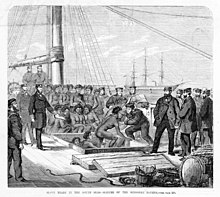Blackbirding

| Part of a series on |
| Slavery |
|---|
 |
Blackbirding is a term to refer to tricking people to work on plantations, or farms for little or no pay. In the 19th century, it was mainly used to refer to people from the Pacific islands working in Australia, Peru, and Hawaii. The people were melanesians and micronesians. When hiring them, fraud, violence and deception were commonly used. In the 1930s, there were international protests that put an end to blackbirding.
During the 19th, and early 20th century, people were taken from the many Pacific Islands. These blackbirded people were called Kanakas or South Sea Islanders. They were taken from places such as Papua New Guinea, the Solomon Islands, Vanuatu, Niue, Easter Island, the Gilbert Islands, Tuvalu, Fiji, and the islands of the Bismarck Archipelago amongst others.
Examples of blackbirding outside the South Pacific include the early days of the pearling industry in Western Australia at Nickol Bay and Broome: Aboriginal Australians were blackbirded from the surrounding areas.[2] Chinese men were blackbirded from Amoy in the 1840s and 50s to work as unskilled labourers in the pearling, gold and farming industries.[3][4]
Practices similar to blackbirding continue to the present day. One example is the kidnapping and coercion, often at gunpoint, of indigenous peoples in Central America to work as plantation labourers in the region. They are subjected to poor living conditions, are exposed to heavy pesticide loads, and do hard labour for very little pay.[5]
Especially the Royal Navy, and different missionary societies saw Blackbirding as a form of slave trade. Blackbirding included a whole system of treaties, where the peopel agreed to be what was called an indentured servant. Even today, people do not agree if this was a form of slavery.
References[change | change source]
- ↑ Emma Christopher, Cassandra Pybus and Marcus Buford Rediker (2007). Many Middle Passages: Forced Migration and the Making of the Modern World, University of California Press, pp. 188–190. ISBN 0-520-25206-3.
- ↑ Collins, Ben (2018-09-09). "Reconciling the dark history of slavery and murder in Australian pearling, points to a brighter future". ABC News. Australian Broadcasting Corporation. Archived from the original on 15 February 2020. Retrieved 2020-03-06.
- ↑ "ASIATIC LABOUR". The Sydney Morning Herald. New South Wales, Australia. 2 December 1854. p. 4. Retrieved 16 August 2023.
- ↑ O'Connell, Ronan (16 January 2021). "Indigenous and Asian slaves were the lifeblood of Western Australia's early pearl industry". SCMP. Retrieved 16 August 2023.
- ↑ Roberts, J. Timmons; Thanos, Nikki Demetria (2003). Trouble in Paradise: Globalization and Environmental Crises in Latin America. Routledge, London and New York. p. vii.
